George catches a cold
Ladybird books, 2017
Based on the TV series Peppa Pig created by Neville Astley and Mark Baker
“Oh dear!” George was out in the rain and now has a cold.
It has been a terrible flu season and so many have been knocked flat. If you, or a little one near you has been sick and needs cheering up, Peppa pig might help bring a smile. Sickness can bring a sense of loss and confusion. Children recovering may be sad from activities missed and other uncertainties. “George catches a cold” could be a good conversation starter, helping parents listen and kids let feelings out.
Peppa pig fans will see a funny side to being sick. “Silly” George doesn’t like wearing his rain hat, he is having so much fun jumping in the muddy puddle and making noise. George throws his hat in the muddy puddle too. Peppa, in big sister fashion “grunts” disapproval, older siblings of toddlers may nod in agreement.
Sure enough, George catches a cold. Mummy pig thanks Doctor brown bear for coming. Your preschooler might relate to opening their mouth wide and saying “ahhh”. Perhaps, like George, they are worried and hold a favourite toy. George gets better and returns to his noisy self, family fun begins again. I hope you enjoy this calm, bright and quirky book, Peppa pig has alot to share.
How to help children cope when they are sick or need medical procedures?
Both health professionals and parents may want to know how to help children cope better during doctors visits and medical procedures. This can be particularly challenging for kids who don’t like to be touched, hate taking medicine, are in pain or experience unresolved fear from previous medical procedures.
Parents may need reassuring that it is OK if their child is crying when it is time for a needle or medical procedure. Paediatric nurse, Brooke Batchelor, hosts a helpful parent blog and Facebook page. In the Emergency department and at home Brooke has found a child laughing is a child releasing tension stored up. Brooke talks about play and “play listening”, little games that start laughter and lead to better coping. Parents and professionals who want to find out more, listen to the Handinhand parenting podcast “assisting children in your office or hospital setting” (50 min). For a quick read article on the value of play and preparing children try Taking the fear out of the hospital, with furry friends and fun by the Mayo clinic.
Why does AWCH keep talking about preparing kids and coping?
AWCH wants to help parents/carers and professionals make healthcare experiences as normal as possible allowing kids to keep on developing. When a newborn baby, young child, child or adolescent is not coping with healthcare experiences and their needs are not met, impacts can be carried into adult life. AWCH values parents and carers finding ways of coping, being less anxious and preparing children. Preparation in advance will help avoid trauma and lifelong negative impacts on health and wellbeing.
More links?
Feedback
Is there something that works for you, for example with pill swallowing? Please share to help others.

















